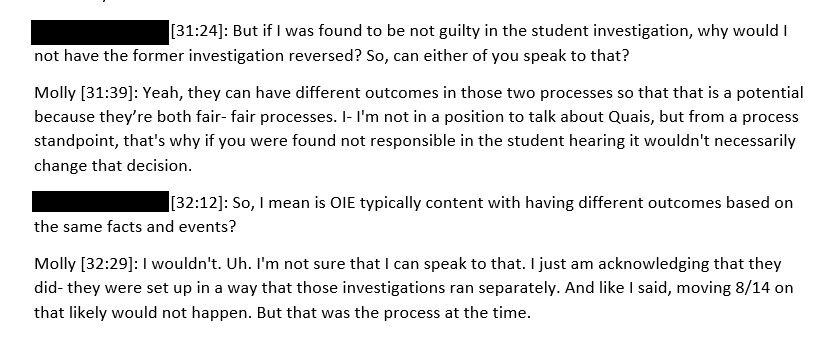The Ohio State University and its Title IX office, including their newest branding into the Office of Institutional Equity (“OIE”), have a longstanding reputation for negligence and/or sweeping misconduct under the rug. They are fresh on the heels of several public scandals, including:
- Failure to investigate or remedy sexual misconduct within the marching band.
In 2014, an investigation was launched into Johnathan Waters, the Director of OSU’s marching band, which found that he had knowledge of a hostile environment created by the sexually charged culture of the marching band for years and failed to address it. Waters either willfully ignored or actively participated in many of the marching band’s overtly sexual antics, such as “ramp night” in which students got undressed and walked into the football stadium, the practice of giving sexually explicit nicknames to rookies, and the band zine “Trip Tic” which at times contained sensitive material about band members.
This scandal revealed a number of dysfunctions within the university’s Title IX investigation procedures, resulting in the Department of Education’s Office of Civil Rights issuing a finding of noncompliance to Title IX later that year.
Instead of taking full responsibility, OSU took steps to mitigate the spread of the story, hiding the investigative report from search engines until the middle of 2022. - Failure to investigate or remedy domestic violence by football coach Zach Smith in 2015 until the news broke in 2018.
As allegations of intimidation, assault, and stalking came to public attention, Zach Smith was fired. Head Coach Urban Meyer at first denied knowledge of the 2015 allegations but admitted to knowing about an incident in 2009 in which Smith was arrested for beating his then-pregnant wife. Both Meyer and other OSU admins had clear and provable knowledge of all the allegations as well as other vices of Smith’s - following a particularly expensive strip club visit of his, OSU added a morality clause to their coaching contract. Meyer had long been in personal contact with Zach’s battered and terrified ex-wife but still chose to lie to the public and keep Zach employed. When this came to light, OSU gave him a slap on the wrist with a 3 month suspension. - Failure to investigate or remedy at least 57 felonies, resulting in four employees fired and the collapse of the Office of Sexual Civility and Empowerment in 2018.
The Title IX office’s dysfunction became so outrageous, with employees struggling for power and ignoring the needs of victims, that OSU kept it under internal investigation for two years. Natalie Spiert, the assistant director, was said to have bullied her coworkers, discouraged inter-office collaboration (including with the Title IX Coordinator and SARNCO!), commented to a group of coaches that they would all go home and beat their wives, compared sexual assault survivors to drug addicts, and told some that they were “not ready to heal.”
Students, SARNCO advocates, and a SCE whistleblower reported that various staff had told survivors that they were lying, “delusional,” that the assault was their fault, or that they would have to embellish their story to be taken seriously. And on top of that, some survivors were pressured to participate in medical research and to have their mouths swabbed during advocacy meetings. So I can’t say I’m surprised that OSU decided to scrap the office and start over instead of trying to reform it. - Failure to investigate or remedy when Richard Strauss sexually abused literally hundreds of students across thousands of reported incidents.
Richard Strauss was hired as an Assistant Physician at OSU’s College of Medicine in 1979. During his 18-year tenure there (and also in the following 2 years at his private practice), Strauss was found by an investigative report in May of 2019 to have sexually abused as many as 177 students, 153 of which were student-athletes. Since then, as many as 521 students have come forward. Strauss was known for inappropriately fondling the young men he treated and often demanding to be shown their genitals even when treating entirely unrelated illnesses/injuries (e.g., in one case, a bloody nose). OSU is known to have began receiving complaints about his conduct as early as 1979, but didn’t launch an investigation into his conduct until 1996 when they terminated him. Even still, he continued to hold a tenured position in the College of Public Health and left with emeritus status in 1998 when he retired.
When, in 2018, survivors began making records requests of his investigation, OSU repeatedly denied, delayed, and manipulated records to deny any knowledge of the sexual abuse he committed all while lobbying the courts to overturn the growing number of lawsuits. In 2021, they succeeded in getting a federal judge to rule that none of the lawsuits could move forward due to the statute of limitations, but this was reversed late last year. Since then, OSU has requested the Supreme Court to reconsider that decision and rule against the lawsuits moving forwards - a request which has received support from over 80 universities.
OSU has announced that it has fully cooperated with bringing Strauss’s abuses to light, having gone as far as to create a “sexual abuse taskforce” to examine its policies, but their previous actions in trying to bury the story and current actions in resisting compensation for Strauss’s victims speak louder than words.
https://survivorsofosu.com/ is an excellent website for learning more.
